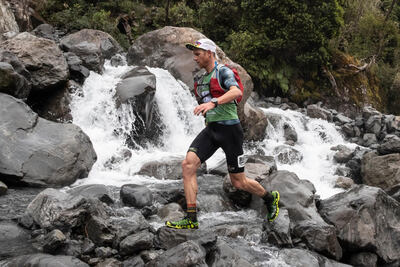There was once a time when my approach to nutrition during an endurance event was largely guess work. I started my endurance career in 2006 and even in some of my early multisport events lasting several hours I would simply throw a banana, a handful of lollies and a can of coke in my backpack and hope for the best.
Some times I remember reaching back for a snack as I got lightheaded (and probably hypoglycaemic) on occasion, and at other times I remember sucking my camelbak bladder dry within an hour of the finish, before hobbling across the line in a dehydrated state and then marching straight to the nearest toilet to stick my mouth under the handbasin tap for the next 10 minutes.
Then there were the times when a lethal cocktail of sugary solids and fluids (such as gels, chews and high concentrate sports drinks without enough water) created so much stress on my gut that everything had to head back out the way it came in order to help restore balance.
Luckily, in the subsequent 18-odd years I learned some more robust details around sports nutrition. And when it came to endurance sport specifically, I started to really dial in two of my greatest nutritional allies: carbohydrates and hydration (fluid and electrolyte intake). Over time, the guess work faded out and was replaced by planning, preparation and execution...
Planning
Part of planning how much to ingest and when to do it came from some baseline guidelines for my race nutrition strategy (60-90 grams of carbohydrate per hour and 500-1500ml fluid with ~1,500mg of sodium per litre).
Part of it also came from some real-world considerations, such as the mode of activity (biking and kayaking were always an easier and more practical place for me to digest higher carbohydrate intakes than running and swimming). The predicted climate also influenced how much I planned to take, as did the intensity and duration of the planned event.
Preparation
When it came to my key events such as the Kathmandu Coast to Coast multisport race and IRONMAN events, I’d generally start gut training in the 6-8 week specific training build that leads to the taper period.
This gave me time to build the intakes up gradually (treating the gut the same way as any other part of the body and being careful not too overload it with too much, too quickly). It also meant that as my training sessions increased in specificity, I could add the nutrition intakes during race simulation sessions to really test, and therefore train, my gut under stress.
Over the years I learned my gut could tolerate carbohydrates at (and even over) the upper end of 90-100 grams per hour, especially while cycling and kayaking. This is likely due to a little bit of favourable genetics and possibly also the result of many years spent racing, whilst eating and drinking along the way, thus building up my gut’s ability to digest larger quantities.
So, when it came to preparation leading into an event, I often liked to use my long ride or brick-to-run as a key weekly gut-training session. The long ride often included race intensity work (for example, 2-3x 20km at race power) which gave me a chance to ingest 90 grams of carbohydrate while revving the engine and energy demands at a similar level to race day.

The run is often a place where athletes will suffer gut distress, hence why I also liked to test my nutrition intake on a session that included running too. My brick run was often 30-40 minutes, including 20-30 minutes at tempo (above race pace).
So, taking 1-2 gels for the run and a fuel belt with my flask of water and electrolytes provided an easily achievable way to test things on the run.
Execution
It's one thing to plan and prepare, but another thing completely to stick to the plan on race day. Executing your planned race from a pacing standpoint and achieving your goal time is often challenging, but so is sticking to a nutrition plan that was planned and prepared for in training.
Often, my best and worst races could be traced back to my ability to execute (or not) on the nutrition side. I have fallen behind targets in the past (due to complacency or dropping a bottle on the bike) and paid the price.
I have pushed more fuel in too, then had to skip nutrition altogether while waiting for my gut to settle or sitting on a port-a-loo. Really it's no different to sticking to every other aspect of your plan (heart rate, power, pacing etc), the more I have made a plan, practiced it before race day and stuck to it on the day, the better my performance has been.
